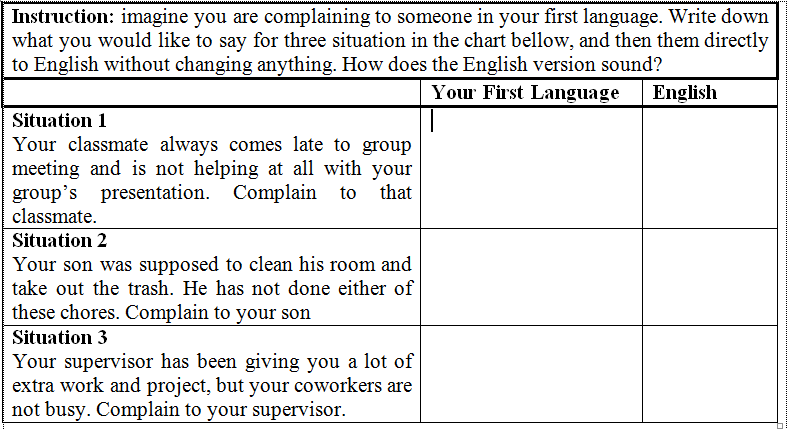How to Teach the Pragmatics of Complaining
Pragmatic competence is the ability to use language appropriately in a variety of contexts. It is an important skill for students to communicate in a second language. Therefore, teaching that focuses on developing students’ skills to communicate effectively in English must include a focus on developing students’ pragmatic competence. Some research proved that cultural differences lead to pragmatic differences among students from different language background (Olshtain & Weinbach, 1993; Murphy and Neu, 1996). They also found that native and non-native speakers’ complaints are different. Non-native speakers tend to complain longer and less severe, while native speakers give shorter, more direct and more severe complaint.
This article is written to suggest several activities for teaching the pragmatics of complaining. Teachers can apply this activities to build students’ pragmatic competence in order to avoid the negative transfer and miscommunication that made by students who learn the second language.
Activity 1: Discussion of Speech Act
To raise students’ pragmatics awareness of cultural norms of the target language the teacher can create a classroom discussion that compare students’ native language and culture with the target language. The teacher create small groups of students, then they can disscuss some questions for the complaint speech act.
The example of questions;
- What is a complaint? What are some situations in which you might complain to someone?
- What do people say to express a complaint in your first language? How is it different from what people say to express a complaint in English?
- Is it common to complain about bad service in your country? Is it common to complain to a parent, a boss, or a teacher? Why or why not?
- Would you complain differently to a friend, a server, and a teacher? Why or why not?
(Hillard, 2017)
Activity 2 : Compare L1 and L2 Complaints
After discussing the questions above, the students compare speech act complaint about some cases in their native and English Language. This activity can raise their pragmatic awareness. In this activity, students should complete this worksheet:
After completing above worksheet, students share their answer with their friends. Then, they discuss some the following questions to identify the possible negative transfers they made when translatin the complaints in English.
- Do your complaints seem polite and appropriate in English? Why or why not?
- In your first language, how you complain differently to a friend, a child, a teacher, and a supervisor? Is this the same for complaining in English? Why or why not?
- How can you improve the complaints you wrote in English?
- Why can’t you just translate complaints directly in English?
(Hillard, 2017)
Activity 3: Read and Listen about Other Cultures Complaints
Reading texts, listening passages and watching video are other ways to raise students’ pragmatic awareness. These activity give explicit information about the speech act in another country. After gaining the information of the speech by reading and listening, student will not only be able to tompare the information of the speeh act in their native language , but they will also be able to apply and produce the speech act of the target language.
They can use this news video for this activity:
http://www.usatoday.com/story/money/personalfinance/2013/05/25/money-quick-tips-effective-complaining/2352371
after watching this video they are supposed to answer several following question:
- What pieces of advice does the woman give for complaints? List them.
- Which piece of advice do you agree with the most? Do you disagree with any of the advice? Why?
- How is the advice different from advice you would give for complaining in your native language?
Finally, as the teacher yo can use these activities in your classroom to teach the pragmatic competence, or, you can adapt them to fit your teaching. Of course, they are many other activties to teach the pragmatic of complaining, but I just write four of them in this article.
References
Hillard, A. 2017. Twelve activities for teaching the pragmatics of complaining to L2 learner. English Teaching Forum 55 (1): 2-20.
Murphy, B., and J. Neu. 1996. My grade’s too low: The speech act set of complaining. In Speech act across cultures: Challangesto communication in a second language, ed. S. M. Gass and J. Neu, 191-216.
Olshtain, E., and L. Weinbach. 1993. Interlanguage features of the speech act of complaining. Oxford: Oxford University Press.
Regard,
ALFYD, English Language Teacher

Just follow n upvote please
@zufrizal